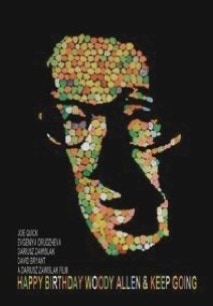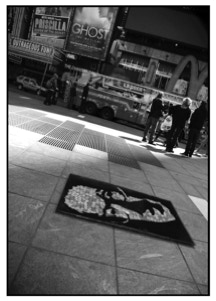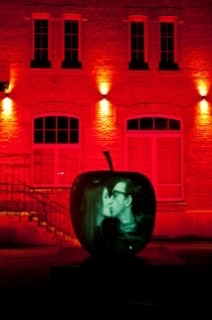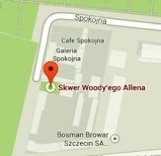2016 PHD GRADUATION
ACADEMY OF FINE ARTS IN GDANSK
DECONSTRUCTING WOODY ALLEN 1,2
I decided to make a deconstruction of Woody Allen’s because I was intrigued by the environment in which he produced his films. I was fascinated by the stories of the city that never sleeps. Manhattan with its ever changing expressions and its residents lost in their own affairs is a rich source of inspiration for his movies. In his movies, Allen attempted to catch everlasting memories of human condition. He was particularly keen on capturing things that he loved and in this way he left piece of himself in each of his film. I observed and researched these elements and presented them in the form of multimedia installation. I intended to extract the essence of distilled Allen and the legacy he created over forty years of film work. As I mentioned before, this work is a continuation of a research taken of the movie: „Happy Birthday Woody Allen and Keep Going!”. I was inspired not only by Allen’s creation, but also his workmanship.
In my work I wanted to follow Allen’s creative process on the movie starting from script through selection of the objects shooting, scenography consistent with the New York environment, cast selection, work on the script with the actors, film implementation including direction. I also decided to participate as a leading actor, although without acting experience it was very hard. I wanted to enhance my understanding of Allen’s workmanship. In my film I included many details from Allen’s private and professional life. In his films Allen created an image of himself as a hypochondriac, neurotic intellectualist who stutters from time to time and non stop waves his hands uncontrollably. There is no doubt that Allen created in his films such an image. During my research I noticed the influence of Allen’s work on my own creativeness and therefore my film.
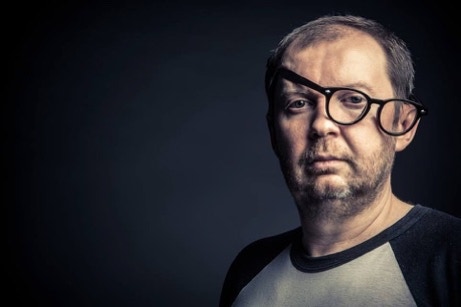
Dr.D.
Here I come to the following argument: Is it true that Woody Allen’s life and particularly his relationships with his women is a range of life experiences moved to the movie screen and then his need to meet this created image? For the research purposes it is essential to recognize and take under consideration proportions of balance and complexity of this argument. The obstacle is the “researcher habit” and his own experience that might impact his understanding of Woody Allen’s work. In “Sensibility and Sense: The Aesthetic Transformation of the Human World“ Arnold Berleant mentions: It is hard to start research without prejudices and conceivably it is impossible“. Therefore in Allen’s „projections“ on my work will become an essential element that leads to.... self - discovery.
WORKS & EXHIBITIONS
Allen Gum
♥ [He_Art]
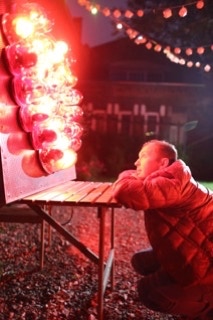
The inspiration for “Happy Birthday Woody Allen, And Keep Going!” came to Mr. Zawislak while in New York City completing an art project which featured a temporary art installation of his original art piece: “Allen Gum” in Times Square.


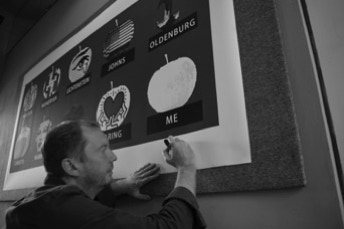
Technological evolution has enabled the emergence of recording life in an almost direct form of its reflection. The tempting imperative to agitate the human figures ossified in a photograph, and initially frozen in the shutter of an apparatus, nowadays, adopted the dimension of the global process of social communication. Different types of portals are trying to surpass the pictorial information chasing the commercialization of mass media. An era of tabloidization has dawned, changing the visibility of the image. It’s harmony is no longer substantial, the quality of the implementation does not count, but only the random moment of recording the event itself. Images transformed into films, and technology developed to such an extent that almost everyone carries a miniature cam, hidden in the super-phone’s tools. A change in perception caused us to accept, without much trouble, the aesthetics of motion picture. Giant server farms gather the life and achievements of human civilization into their memory. The line between personal memory and collective memory has been blurred. Most of our activities are being made public and, increasingly, even our most intimate moments. One might then ask: What about cultural memory? Again, we are becoming a pictorial society. It is no longer words or sentences, but moving images, which bestow a multitude of different interpretations, uncovering the layers and that which in them is viable, and from its essence, elements that are tuned into one another assemble. But not just images, also sounds, words, and music, united into one medium - film. A medium, which replaces, or at least shortens the border line between the real world and its reflection. And although, it only slightly modifies daily life - slightly coloring it, simultaneously it can not overly depart from it, as to not arouse an impression, missing the model recipient. And here, finally appearing, a statement cited by Woody Allen: "Ilove being reduced to a cultural stereotype". But that’s how the media is, illusorily portraying life, full of stereotypes. In one of Allen’s most renowned films "Manhattan", his hero criticizes television, which has been lowering requirements systematically for years. If that’s the case, how is it possible that Allen’s films are present not only in theaters, but also on television? Well, he portrayed a character that is emotionally unstable to a great extent, neurotic, prone to anxiety, ideally fitting the stereotype of an artist. Allen irradiated our mind by creating complex metaphysical scenes as well as scenes that converge symbolically, whose illusory simplicity does not predispose it to obtaining the depth of the expression and that's why it acquires this meaning. Concurrently, Woody Allen became the creator and the material. By embalming himself in his films, he gave us a simple message, how not to undergo atomization. We exist in a world of immanent illusion, embraced by an optical dimension. Driven by consumerism resulting from unmet impulses, inherent in the aporia of social communication. Fortunately, in time, I managed to avoid atrophy - by finding myself on the other side of the screen. I was able to consciously refer to the cultural resources of art as a postmodern absorber of sensory reality. At least in my case with the preserved, after all, peculiar sovereignty of the language of film. In 2011, I began a deconstruction, whose basis was to become acquainted not only with the works of Woody Allen, but also with his personal life, permeating into the realized films as well as the work methodology regarding their creation. Just to, in the light of personal reflection, produce a film for Woody on the occasion of his birthday on December 1st, 2012. "Happy Birthday Woody Allen and Keep Going!" was presented in New York. In this film, independent filmmakers expose the mechanism of the individual economics of inclination, controlled by media companies and their legal departments or the more or less bloodsucking offices, as they realize the hallow objectives, namely the aforementioned film. Once again, reality is transferred to film and the director, like Allen, embodies the character of one of the heroes. The inherent driving force is represented by the "patrons" of cultural industry, personified as popcorn vendors, which as an appetizer to cinematic work, becomes a motive for its formation. Another exchange of the situation ensues. It is thanks to the profitability of the production of this addition that the film emerged, to further increase sales revenues. However, pseudo-heterosexuals kidnappers, with their faces veiled in cloth colored like a rainbow, stand in the producers’ way, and in addition, they parade about in tight golden shorts. It is them who intend to kidnap Allen, so that he may write a special musical screenplay for them. Characteristic Mossad agents were not lacking, departing on a mission to protect the cultural icon that is undoubtedly Woody Allen. I could delve further into the semiotic analysis of the film, but it will only be one of the possible versions. So I will cease in this moment, and invite to the screening, as each new reconstruction will be a different interpretation and implementation. Reviving a new in front of the spectators' eyes.
Contemporary Zelig


Rockaway Beach 10!

The Sky Over The Bronx December 1st 1935 10:55 pm.
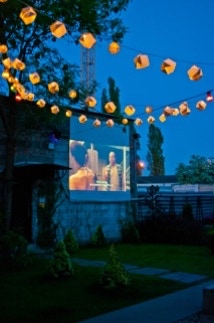
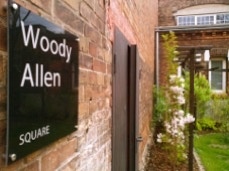


Screening Blue Jasmine at WASQ
1. Deconstruction (French: déconstruction) is a form of semiotic analysis, derived mainly from French philosopher Jacques Derrida's 1967 work Of Grammatology. Its first task, starting with philosophical texts and afterwards in literary and juridical ones, is to overturn all the binary oppositions of metaphysics (signifier/signified; sensible/intelligible; writing/speech; passivity/activity; etc). Derrida's theories of Deconstruction first demonstrate that in a classical philosophical opposition readers are not confronted to the peaceful coexistence of a vis-à-vis, but rather with a violent hierarchy.One of the two terms governs the other (axiologically, logically, etc.), or one of the two terms is dominant (signified over signifier; intelligible over sensible; speech over writing; activity over passivity; male over female; man over animal, etc). The deconstruction of the opposition, is to overturn the hierarchy at a given moment. To overlook this phase of overturning is to forget the conflictual and subordinating structure of opposition.The final task of deconstruction is not to surpass all oppositions; because it is assumed that they are structurally necessary to produce sense, they cannot be suspended once and for all. They need to be analyzed and criticized in all their manifestations; the function of both logical and axiological oppositions must be studied in all discourses to provide meaning and values. Deconstruction does not only expose how oppositions work and how meaning and values are produced in a nihilistic or cynic position, "thereby preventing any means of intervening in the field effectively". To be effective, and simply as its mode of practice, deconstruction creates new notions or concepts, not to synthesize the terms in opposition, but to mark their difference, undecidability, and eternal interplay.

2. Woody Allen (born Allan Stewart Konigsberg; December 1, 1935) is an American screenwriter, director, actor, comedian, author, playwright, and musician whose career spans over half a century. He began as a comedy writer in the 1950s, penning jokes and scripts for television and also publishing several books of short humor pieces. In the early 1960s, Allen started performing as a stand-up comic, emphasizing monologues rather than traditional jokes. As a comic, he developed the persona of an insecure, intellectual, fretful nebbish, which he insists is quite different from his real-life personality.In 2004, Comedy Central ranked Allen in fourth place on a list of the 100 greatest stand-up comics, while a UK survey ranked Allen as the third greatest comedian. By the mid-1960s Allen was writing and directing films, first specializing in slapstick comedies before moving into more dramatic material influenced by European art cinema during the 1970s. He is often identified as part of the New Hollywood wave of filmmakers of the mid-1960s to late '70s.Allen often stars in his own films, typically in the persona he developed as a standup. Some of the best-known of his over 40 films are Annie Hall (1977), Manhattan (1979), Hannah and Her Sisters (1986), and Midnight in Paris (2011). Critic Roger Ebert described Allen as "a treasure of the cinema". Allen also performs regularly as a jazz clarinetist at small venues in Manhattan, including the Carlyle Hotel on Monday nights.
Self Control

Woody Allen Square

